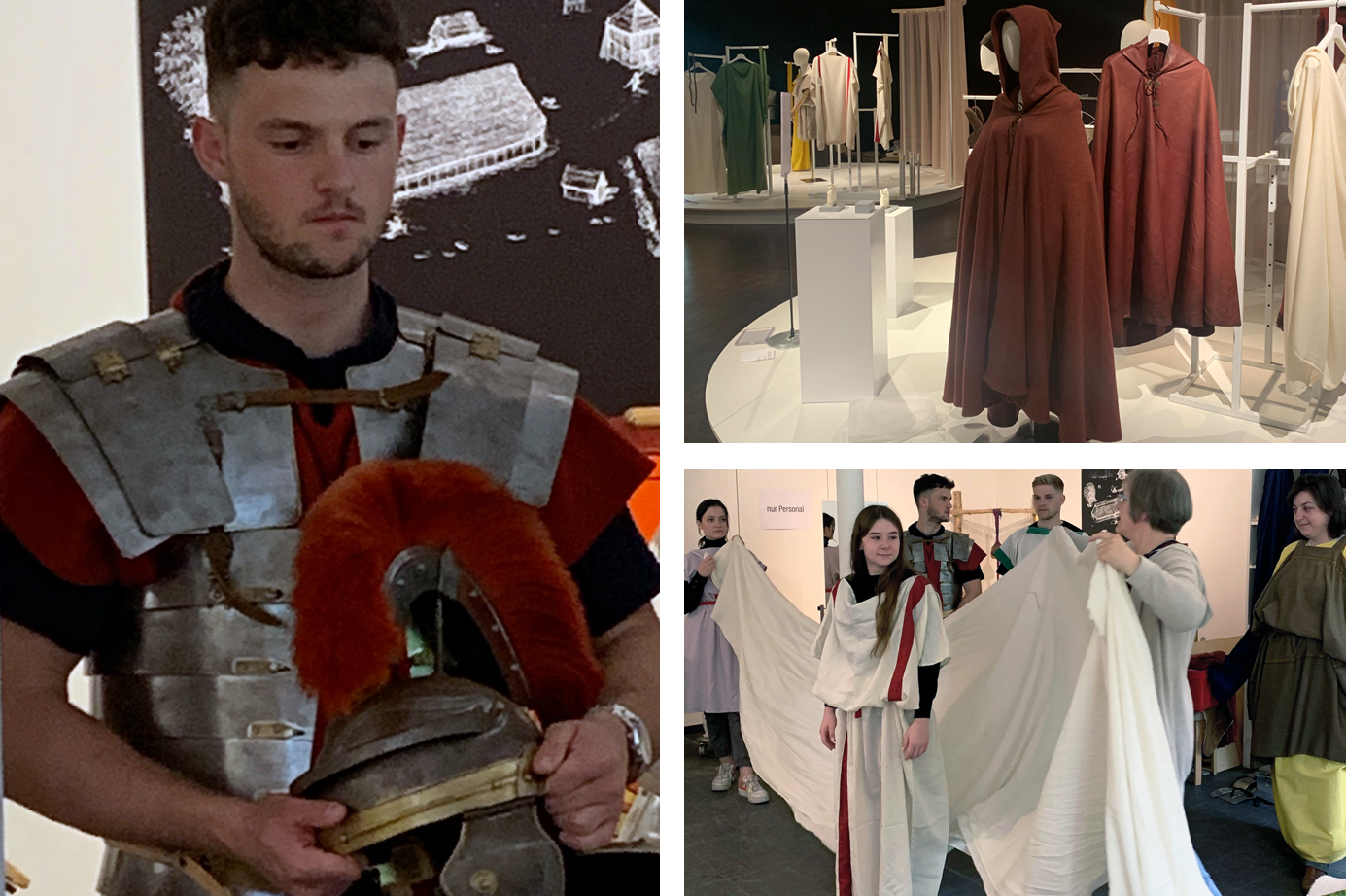Main content
Top content

Modul researching and presenting in scientific context
The art of wearing yourself - Frida's closet
Frida Kahlo is considered one of the most important artists of the 20th century. She exemplifies the combination of personal experience, political stance and aesthetic expression. Her works, her biography and her extraordinary style of dress make her an outstanding figure of cultural identity and artistic self-presentation. This complexity opens up a variety of approaches, particularly in the field of design education. In this context, a two-semester project seminar was held in Textile Design as part of the module Research and Presentation in Academic Contexts. The module focused on the examination of Frida Kahlo with regard to her fashionable self-presentation, combined with scientific research, textile design work and the conception of an exhibition. Over the course of the two seminars, the students developed an exhibition entitled "The Art of Wearing Yourself: Frida's Wardrobe" under the direction of Lesley-Ann Baldwin and Christine Löbbers.
Further information: Lesley-Ann Baldwin, lesley-ann.baldwin@uni-osnabrueck.de; Christine Löbbers, christine.loebbers@uni-osnabrueck.de
Graphics: Luzia Meyer-Rohen, Lesley-Ann Baldwin.
-------

Modul researching and presenting in scientific context
The veestimentary code of sweatpants
Textile Studies students questioned the image of jogging bottoms and their wearers in a seminar led by Reiner Wolf. The seminar showed that jogging bottoms have undergone a remarkable development in recent decades. More and more people are wearing them not only at home or for sport, but also in public, when shopping or at work. For many, they have become an integral part of the wardrobe. The meanings with which this textile can be loaded make jogging trousers a medium of self-expression - and an exciting object for a seminar on vestimentary codes.
Further information: Bärbel Schmidt, baerbel.schmidt@uni-osnabrueck.de
Photo: Reiner Wolf.
-------

Modul researching and presenting in scientific context
General and process:
The research and presentation module in scientific contexts is about the following qualification objectives: scientific processing and presentation of research results in the form of exhibitions, presentations or publications, scientific development of complex issues, discussion of sources and research literature as well as their critical evaluation and classification, Exhibition management and curatorial practice. The content includes central topics in the field, such as sustainability, digitalization, gender, transculturality, migration, textile art, smart textiles, current and past fashions, etc.; the development of an exhibition concept (individually or in small groups), exhibition design and management, museum education; the scientific development of a topic, compilation of suitable exhibits, creation of exhibition texts and object labels; Public relations and design, editing and proofreading as well as setting up and dismantling the exhibition.
Offer cycle: Start of each summer semester, continued in the winter semester.
First module run: DRESSED – Rome Makes Fashion. Cooperation project with the Kalkriese Museum
The exhibition DRESSED presents the cooperation between Textile Studies and the Kalkriese Museum. The collaboration addressed questions such as: What were popular pieces of clothing worn by the Romans? What clothing attributes conferred power and status? What materials and textile techniques were used? The project, which extends over two semesters, is the first round of the research and presentation module in scientific contexts according to the new examination regulations (2021) in the textile design teacher training course. The aim of the module is to enable students to use practical examples to scientifically address research questions in the form of exhibitions, presentations or publications in order to acquire the necessary theoretical, practical and social skills for their future professional life. In preparation, the students worked on the topics of fashion and sustainability in ancient Rome, especially during the era of Emperor Augustus. The intention was to examine the sartorial past of this time in all its many facets. This included research questions about Roman fashions, fashion behavior, production, sustainability, trade and customs. At the same time, opportunities for a more sustainable fashion industry in our time should be explored. The findings should be presented to the public in an exhibition beyond the academic world. The DRESSED exhibition gives an impression of how the collaboration with the Kalkriese Museum offered the students exciting practical insights into the museum's research and communication work, but at the same time also of the influence the learners had on the museum's communication of their findings and how the museum of benefited from the collaboration. The students involved in the project received support from fellow students who worked on the production of the textile exhibition objects because of their interest and from three textile-loving citizens of Osnabrück. The coordination of the production of the numerous textile objects such as tunics, togas or stoles was in the hands of textile lecturer Christine Löbbers, who herself was also involved in the sewing process. The team of textile design students and teachers sewed, dyed, documented on film and prepared for the exhibition. The master carpenter from the University of Osnabrück, Jürgen Menkhaus, worked closely with the museum to create a functional weight loom, which is one of the highlights in the exhibition. At this point, we would like to thank everyone involved from the university and the museum; their support made the ambitious project possible. The special exhibition DRESSED – Rome Powers Fashion can be seen at the Kalkriese Museum until November 24th, 2024.
The taz reports on the exhibition: “‘Dressed’ is one of the most unusual and at the same time most successful exhibitions that this museum has shown in recent years. (...) A bold mixture. The fact that it succeeds is also thanks to the Department of Textile Design at the University of Osnabrück, which helped design it, including political messages.” taz.de/!6018898/
Further information: Prof. Dr. Bärbel Schmidt.
Photos: Bärbel Schmidt.
-------

